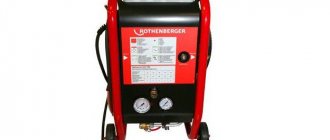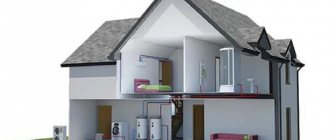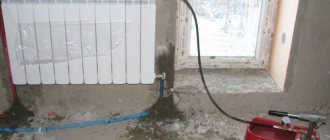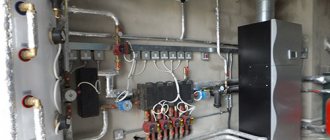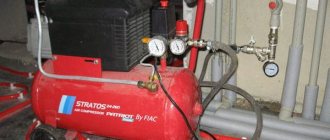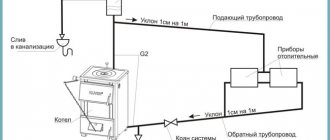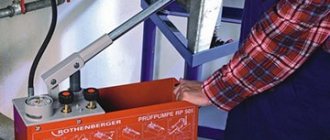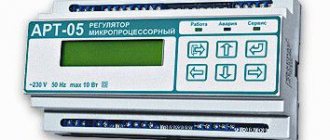Requirements for standards for hydrotesting of heating
According to document SNiP 41-01 of 2003, a similar process for water heating systems is allowed to be carried out at above-zero temperatures in the building. The system must function as efficiently as possible and withstand a fluid pressure of 0.6 MPa, otherwise depressurization and damage to some components cannot be avoided.
Pipelines and fittings together with devices should not be subjected to the maximum pressure values that were provided for during installation. Hydrostatic tests assume the use of a load equal to 1.5 times the operating state of the system, but not less than 0.2 MPa, in relation to the lower part of the pipeline.
The work can be considered successful if all communications last for 10 minutes; the pressure during this period should not drop by more than 0.02 MPa.
Crimping certificate
Pressure testing can only be carried out by authorized licensed organizations that service heating systems of residential buildings. In apartment buildings, these events are carried out by the service office. Upon completion of the tests, a corresponding document is issued. The form of the certificate for pressure testing the heating system is given below.
The document must contain the following mandatory items:
- The name of the system or section, as well as its length.
- Testing instruments and instruments used to carry out the tests.
- Duration of crimping and pressure created.
- Values on instruments that were obtained during the activities.
- The act is signed by the customer, the foreman who carried out the crimping, and the person accepting the work. The certificate of the specialist responsible for conducting the tests must be indicated.
The responsible person for carrying out work in an apartment building is the utility service. When conducting hydrotests in a private house, the owner of the house is considered the responsible person.
Crimping price
The total cost of the work is calculated in the final estimate, which indicates all the activities and tests carried out. It is impossible to indicate the exact amount, since much depends on the type of wiring, the state of the system and other parameters.
When calculating the final cost of work, the following is taken into account:
- The volume of work carried out depends on the size of the house and the branching of the network.
- Condition of the heating system. It is cheaper to test on a new system or networks that have been serviced not long ago. If you have to deal with old networks that have not undergone preventive maintenance for a long time, the price will be higher.
- The number of flaws and damages, as well as the complexity of repair and restoration work are taken into account.
If, after hydrotesting, leaks and parts that need repair or replacement are identified, then repair operations are carried out by a qualified specialist. The cost of these works is also included in the total estimate. After repair and restoration activities, repeated pressure testing is carried out. All work performed is included in the total cost of testing activities.
Purpose of testing
The main must be checked for integrity and tightness; this is precisely why the system was developed; testing of pipes and components makes it possible to timely detect gaps in threaded pipes and assess the tightness of heating or hot water supply connections.
Without such actions, one cannot count on a minimal threat from leaks and flooding of premises. Before putting the highway into operation, an inspection is carried out; this process is mandatory for implementation.
Pipeline hydraulic testing technology
Using liquid for the process is a fairly popular method; with the help of such manipulations it will be possible to test all the circuits of the system.
Water is pumped through a special tap, which is located at the bottom of the pipes. It is not prohibited to use automatic pumps for work; manual ones connected to the water supply can also be used.
High rates of detection of possible excesses are the main positive side of this method; manipulations can also be performed without much difficulty. Visually, you can identify fluid accumulations in weak spots and troubleshoot problems in the line, which is quite convenient and practical.
Preparatory work
There are special pressure testing pumps; this equipment is prepared first. There are both manual models and electrical samples; specialists choose the most convenient version for testing. You also need to use a pressure gauge in the process to monitor changes, because some units are capable of pumping from 40 to 100 bar.
Pressure test pump
The Ministry of Energy draws attention to the correct approach to performing the flushing procedure, and the accuracy class of the measuring device should not be lower than 1.5. The circumference is important in the process; the body should be selected taking into account data exceeding 160 mm.
Determination of strength and tightness
To identify problem areas, the procedure must be carried out at operating pressure; a visual inspection is carried out by tapping a rounded shape with a hammer. When it comes to pipes made of non-ferrous metals, a wooden specimen weighing no more than 0.8 kg is used.
Tests for strength and tightness can be considered satisfactory if the pressure during exposure does not fall below the established norm; the data must be viewed on the pressure gauge. Welds, connections and other fittings must be dry; if such problems are detected, all excesses are eliminated, and the work must be repeated to obtain a hydraulic test certificate.
Testing
The detailed algorithm of actions is quite simple, it is important to adhere to the sequence of manipulations, it all looks like this:
- Using a pressure tester, it is necessary to fill the entire circuit with water, which should be at least 45 degrees. The air is released through special taps, they are called vents.
- Injection lasts 10 minutes, during which time it is necessary to carry out a visual inspection of the fittings, joints, seams and connections.
- The pressure can be increased to the maximum, and held for a certain time; it should be noted that products made of polymer materials, the pressure in them must be left for 30 minutes, for better manipulation.
- Using a pressure gauge, you can identify deviations in readings; if they are normal, then the result of the work should be considered satisfactory.
After such manipulations, the system will be operated as productively as possible; all areas are suitable for use. Otherwise, the nuances should be eliminated; if leaks or fluid accumulation occur, the unit or pipe section should be replaced.
Pipeline testing pressure
This point should be taken seriously, because there are some requirements that should be taken into account and fulfilled. It goes like this:
- For steel pipes with values of 4 kgf/cm2 and specimens with a wall that allows operation at temperatures above 400 degrees, 1.5 working pressures are maintained, but not less than 2 kgf/cm2.
- With indicators of 5 kgf/cm2, 1.25 is enough.
- Cast iron, glass, plastic, 1.25.
- Pipes made of non-ferrous metals will require a pressure of 1 kgf/cm2.
- Phaolite samples 0.5 kgf/cm2.
Mobile type plunger pumps are considered to be in greatest demand for work. Piston hand units can also be used; presses, gear-type drives and operational models are perfect for pumping up the required parameters.
Drafting of documents
The owner of a private building will need to contact the district offices, while residents of multi-apartment buildings can count on help in this matter from utility companies. When filling out the application, you must carefully consider all points; the information is entered exactly as it is in reality; the address is also required. The report form must include information about who carried out the inspection; the organization provides papers with an approved signature from the chief power engineer.
Hydropneumatic tests
As a rule, control pressure testing and washing are recommended to be carried out at the end of the heating season. If at this time it is possible to identify weak points and defects in the system, then there is a whole season ahead without heating, when repair work can be carried out. After major or routine repair work, the networks are again filled with water and re-pressurized. This is usually done in the fall.
Hydropneumatic tests are carried out in the following sequence:
- At the end of the heating season, the condition of shut-off valves, heating and elevator units, as well as heating risers is checked.
- Preventative flushing of pipelines is carried out to clear various blockages.
- During flushing, the entire line, equipment and components are inspected for leaks. If any are identified, urgent repairs are carried out.
- The condition of thermal insulation of open sections of pipelines is checked.
- Then they carry out pressure testing and fill the networks with standard coolant so that they are completely ready for the new heating season.
To carry out hydropneumatic testing, the circuit is filled with water, then an electric or manual pump is connected, and the pressure is raised to the required level. Pumping equipment must be equipped with a built-in pressure gauge.
To check the intra-house network, the pressure is increased 1.5-2 times, starting from the operating value. When testing old networks, it is enough to increase the pressure by 25-50% of the operating parameter. The test pressure indicator depends on the limit value that the devices installed in the network can withstand.
Certificate for hydraulic testing of the heating system
You can download a sample act here.
After filling out the header, information about the acceptance committee is entered into the document, which includes:
- Customer.
- Contractor.
- Representative of the installation organization.
The last name, first name, and position columns are filled in sequentially; such manipulations are performed with each member of the commission. The fact that hydraulic tests were carried out is definitely mentioned, after which they move on to the next part of the regulatory document.
The block concerning direct work is not difficult to fill out; the algorithm of actions is simple:
- The pressure that was maintained during the test, these data are indicated in two options: kgf/cm2 and MPa.
- A drop in performance during the process.
- The presence of excesses and defects that were discovered by specialists.
Conclusions are based on real facts; the installed system can either meet the requirements or not. After passing the inspection, all those present sign, confirming the authenticity of the hydrostatic test report. The process cannot be called complex, but there are some nuances that should be taken into account long before targeted actions.
Experts advise addressing the issue before starting finishing work, because hydraulic tests of the heating system may fail. Repair work of a decorative nature will certainly suffer; eliminating the consequences will take not only time, but also extra money.
As soon as a report is drawn up based on the results of the inspections, construction or reconstruction of the premises can continue, if the building is at this stage. You can familiarize yourself with the document in detail quite easily; you just need to look at the example of a completed hydraulic test report for heating system pipelines.


